Will you have a plastic bag or the plague?

By Deborah D. Thornton
Like environmentalists in San Francisco, the Iowa City group 100 Grannies promotes a ban on plastic bags. Unfortunately, they are not “saving the environment,” they are actually spreading norovirus.
Norovirus causes vomiting, diarrhea, cramps, chills, fever, headache, muscle aches and fatigue. It has made hundreds of cruise ship passengers sick. If someone has the “stomach flu” or “food poisoning,” in most cases they really have norovirus.
Noroviruses cause more than half of food-borne illnesses, are highly contagious and hard to kill. Norovirus is “one of the most infectious viruses known to man,” according to the Center for Disease Control. he only thing that kills it is five to 25 tablespoons of bleach per gallon of water.
It reminds me of the plague or Ebola.
As a major case study in Oregon revealed, norovirus is transmitted through a reusable grocery tote. A bag of cookies, chips and grapes for a girls’ soccer team were contaminated with norovirus, resulting in severe vomiting, diarrhea and hospitalization. When the bag was tested – two weeks later – it still contained norovirus.
BAN THE BAGS: Many environmentalists are promoting a ban on plastic bags, but unfortunately they are doing more harm than good.
In other tests, half of reusable grocery bags had coliform bacteria on them and eight percent had E. coli — fecal contamination.
All the 100 Grannies and “Ban the Bag” efforts are doing is making our children sick. OK, Granny is sorry — but we’ve got to save the environment! So Granny, start washing and bleaching your bags, weekly.
Unfortunately, only 3 percent of people wash their bags, according to the University of Arizona and Loma Linda University. Filthy fabric bags make more than 19 million people sick every year in the U.S. alone. Health care crisis, anyone?
“But we all know plastic bags are a major landfill contributor, emit greenhouse gasses and are made from oil.”
None of those statements are true. Your common plastic bag is made from 80 percent polyethylene.
Polyethylene is a waste product of refined natural gas, not oil. Ethylene in natural gas must be removed before it can be used, and if not it burns off as greenhouse gas, a real environmental hazard. This ethylene is used to make plastic bags, and is actually helping by using waste material.
Plastic bags “require 70 percent less energy to manufacture and transport than paper bags, generate 50 percent less greenhouse gas, and create 80 percent less waste” during manufacturing and are 100 percent recyclable.
Most are reused three times before going in the trash. When recycled they are made into construction and building products. As the bags are exposed to sunlight they become brittle and break up, they don’t remain whole forever.
The three largest types of landfill waste are paper products (27 percent), food waste (15 percent) and yard trimmings (14 percent). The amount of plastic bags in landfills is less than 0.6 percent, according to trash and litter experts at Environmental Resources Planning.
In San Francisco, the plastic bag trash actually increased after the ban, from 0.59 percent in 2007 to 0.64 percent in 2008. Additionally, by 2013 the amount of paper bag trash was 44 percent.
Of three cities studied — Oakland, Calif., Washington, D.C. and San Francisco — San Francisco had the most paper bag trash at 86 percent of the total.
So the problem in San Francisco is people who litter — no matter which bag they use. But, San Francisco aside, “plastic bags litter the road.” According to the Keep America Beautiful Foundation this is not true. Ninety percent of U.S. roadway trash is less than 4 inches in size, and the Number One trash is cigarette butts, not plastic bags.
If the 100 Grannies want to really help — instead of making their grandchildren sick — they would advocate against littering — of any sort. They should not use cloth bags for groceries or snacks. If they persist in this misguided behavior they should have to clean up their grandchildren’s throw up.
Copyright © 2014 Public Interest Institute, All rights reserved.
The views expressed in this column are those of the author and not necessarily those of the Public Interest Institute. They are brought to you in the interest of a better informed citizenry.







